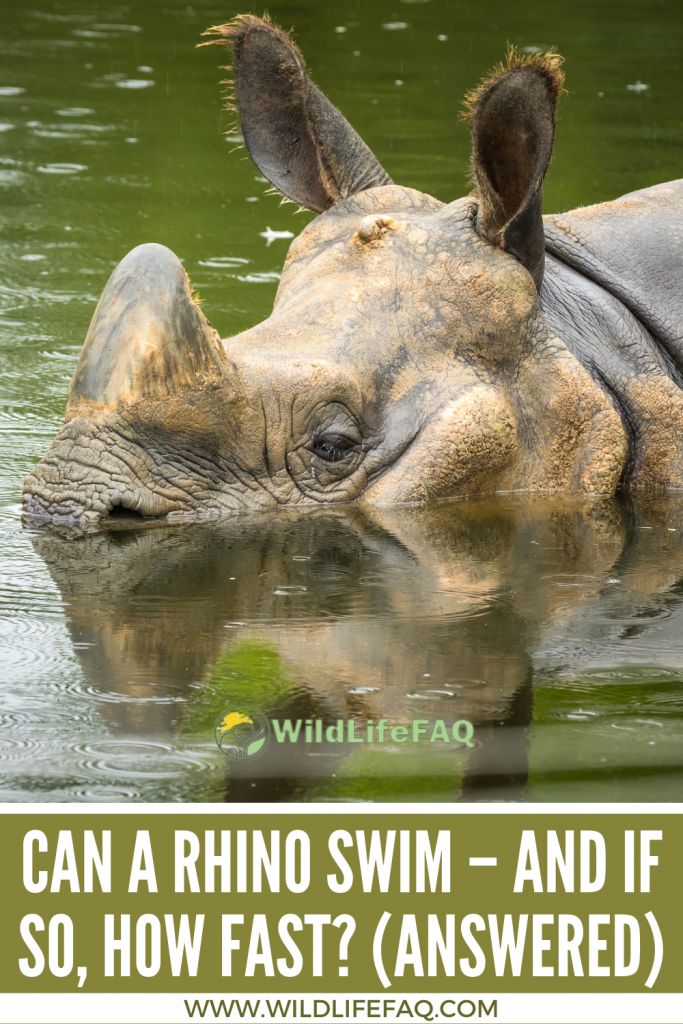Rhinos love to be in the water, wallowing in the mud and water to stay cool in the hot climate. Some of them are great swimmers – and others – not so much.
How Well Can A Rhino Swim?

Rhinos aren’t semi-aquatic like hippos – and so don’t actually need to be able to swim. They are huge in weight and although they need to be near a source of water for drinking, they don’t often cross large rivers or lakes when wandering around.
African rhinos – the Black Rhino and the White Rhino – can’t really swim that well at all. They will certainly walk into shallow water and wallow, or lay down to cool off – but as they can be over 121cm (4ft) tall at the shoulder – they can walk through most small rivers without needing to swim at all. Luckily for adult rhinos – the water isn’t a dangerous place as they aren’t really the first choice for crocodiles (however, larger adult crocs may well still consider a young rhino as a possible lunch).
The three Asian/South-East Asian rhinos (Indian, Sumatran and Javan) love the water and can travel through forest habitat no matter if it’s on solid ground or under flood-water. The Sumatran and Javan rhinos do need dry land though to feed on – but the Indian, or Greater One-horned Rhino – actually really enjoys a swim.
They are known for spending more time in the water than other rhinos as they have a soft spot for eating water plants (rather than just the scrub and grasses eaten by the other 4 species). They have even been seen swimming down under the water to feed on plants – something not reported to have been seen in other rhinos.
How Fast Can Rhinos Swim?
Rhinos aren’t racers in the swimming world – and there aren’t many actual reports of swimming speeds of any rhino as a result. The Indian Rhino is the most aquatic of all the rhinos – but really doesn’t swim much either in the true sense. They tend to just stay submerged in water for long periods of time – bobbing below the surface here and there to feed or avoid flies.
Both the Sumatran (aka the Hairy Rhino) and Javan (also known as the Lesser One-Horned Rhinoceros) spend a decent amount of time in the water – but again – usually always with their feet on the bottom. The Sumatran has been seen in the sea too – which is rather a strange sight. Of course, they don’t actually swim in the ocean – just wade out into the deeper areas to get themselves cooled down and away from pests.
The White and Black rhinos do not really swim at all – and have been known to drown in waters. They are more land-based rhinos out of the 5 – and their diets are more grassland and savanna – so less reason to go into water regularly. They just wallow in the mud puddles. It is believed that is how the Black Rhino got its name – from the colour it went when wet and covered in mud.
Mud is great for protecting the skin from the sun – and they would ideally drink fresh water every day (up to 70 litres (80 gallons) a day in good conditions) however they can go without for several days if they need to.
Can Rhinos Put Out Fires While They Are Swimming?
Rhinos and fire response: While rhinos are strong and formidable creatures, putting out fires while swimming is beyond their capabilities. Rhinos have thick skin and are excellent swimmers, but their primary instinct is to flee from danger rather than actively engage in firefighting. Leave the task of combating fires to trained professionals equipped with the necessary equipment and expertise.
Is Swimming Dangerous For Rhinos?
Rhinos don’t really have any true aquatic predators, so being in the water isn’t as dangerous for them as it is for other animals. Crocodiles are the scariest predator but they won’t attack a full-sized adult. However, if the rhinos annoy a family of hippos they could be in serious trouble. Hippos are probably more dangerous to most large mammals – and humans – than crocodiles are.
For Asian and South-East Asian rhinos – being in the water could be more dangerous than on land if they were being stalked by a big cat. Tigers often hunt in wetlands and could easily sneak up on a snoozing rhino in a river. Tigers are very adept at catching prey in their wetland habitat – as are jaguars – so the rhino (especially if a youngster) would be at a serious disadvantage.
Rhino does have extra thick skin though – so they do have a chance to avoid serious injury during an attack – it just depends on a lot of factors. However, there are so many parasites that could strike down an injured rhino – that a failed big cat or hippo attack could still eventually kill them.











